1997 BUICK REGAL parking brake
[x] Cancel search: parking brakePage 77 of 422
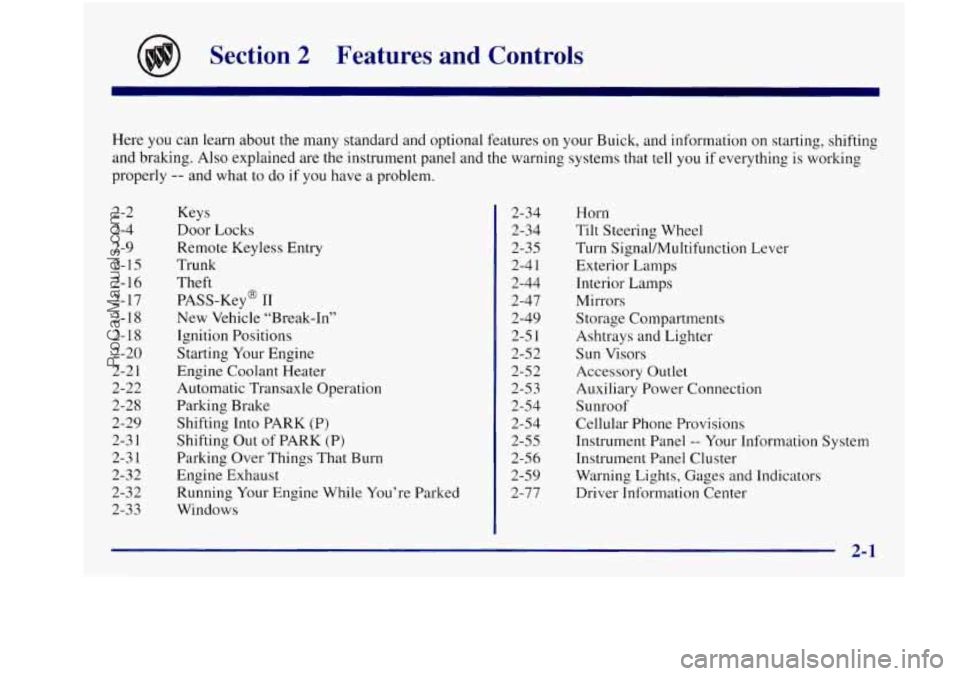
Section 2 Features and Controls
Here you can learn about the many standard and optional features on your Buick, and information on starting, shifting
and braking. Also explained are the instrument panel and the warning systems that tell you
if everything is working
properly
-- and what to do if you have a problem.
2-2
2-4
2-9
2-15
2-16
2- 17
2-18
2-18
2-20
2-2 1
2-22
2-28
2-29
2-3
1
2-3 1
2-32
2-3 2
2-33 Keys
Door
Locks
Remote Keyless
Entry
Trunk
Theft
PASS-Key@
I1
New Vehicle “Break-In”
Ignition Positions
Starting Your Engine
Engine Coolant Heater Automatic Transaxle Operation
Parking Brake Shifting Into PARK
(P)
Shifting Out of PARK (P)
Parking Over Things That Burn
Engine Exhaust
Running Your Engine While You’re Parked
Windows 2-34
2-34
2-35
2-4
1
2-44
2-47
2-49
2-5 1
2-52
2-52 2-5 3
2-54
2-54
2-55
2-56 2-59
2-77 Horn
Tilt Steering Wheel
Turn Signal/Multifunction Lever
Exterior Lamps
Interior Lamps
Mirrors
Storage Compartments
Ashtrays and Lighter
Sun Visors
Accessory Outlet
Auxiliary Power Connection
Sunroof
Cellular Phone Provisions
Instrument Panel
-- Your Information System
lnstrument Panel Cluster
Warning Lights, Gages and Indicators
Driver Information Center
ProCarManuals.com
Page 99 of 422
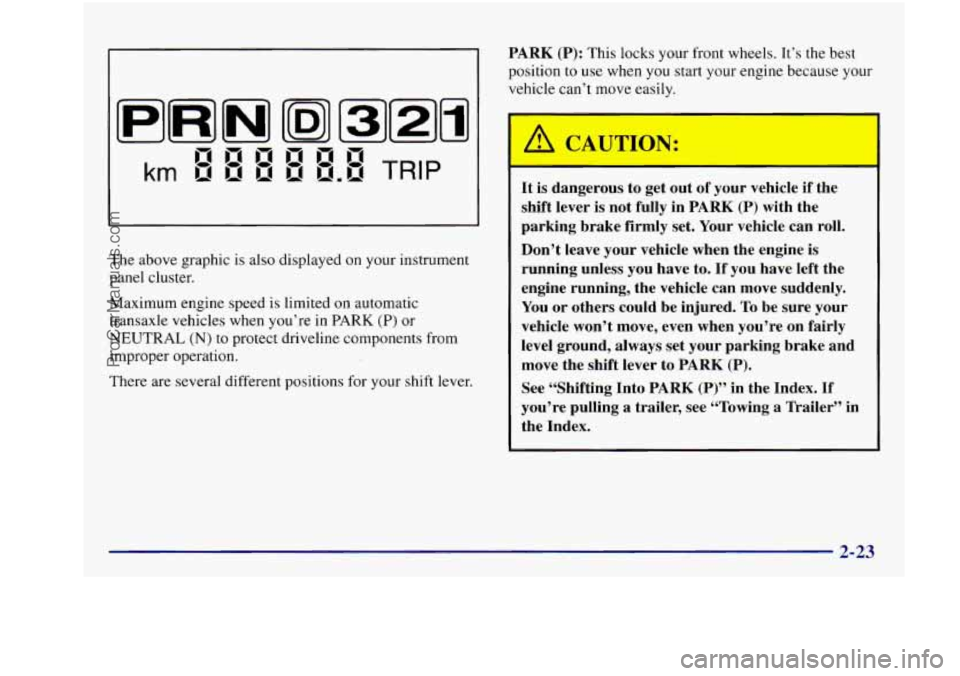
I I PARK (P): This locks your front wheels. It’s the best
I position to use when you start your engine because your
I I vehicle can’t move easilv.
-:
d
B I B I B!I BJ LI ------
km Irr Irr ,,r u ,,r,,,r TRIP
It is dangerous to get out of your vehicle if the
‘I
shift lever is not fully in PARK (P) with the
parking brake firmly set. Your vehicle can roll.
The above graphic is also displayed on your instrument
panel cluster.
Maximum engine speed
is limited on automatic
transaxle vehicles when you’re in PARK (P) or
NEUTRAL
(N) to protect driveline components from
improper operation.
There are several different positions for your shift lever.
Don’t leave your vehicle when the engine is
running unless you have to.
If you have left the
engine running, the vehicle can move suddenly.
You or others could be injured.
To be sure your
vehicle won’t move, even when you’re on fairly
level ground, always set your parking brake and
move the shift
lever to PARK (P).
See “Shifting Into PARK (P)” in the Index. If
you’re pulling a trailer, see “Towing a Trailer’’ in
the Index.
2-23
ProCarManuals.com
Page 104 of 422
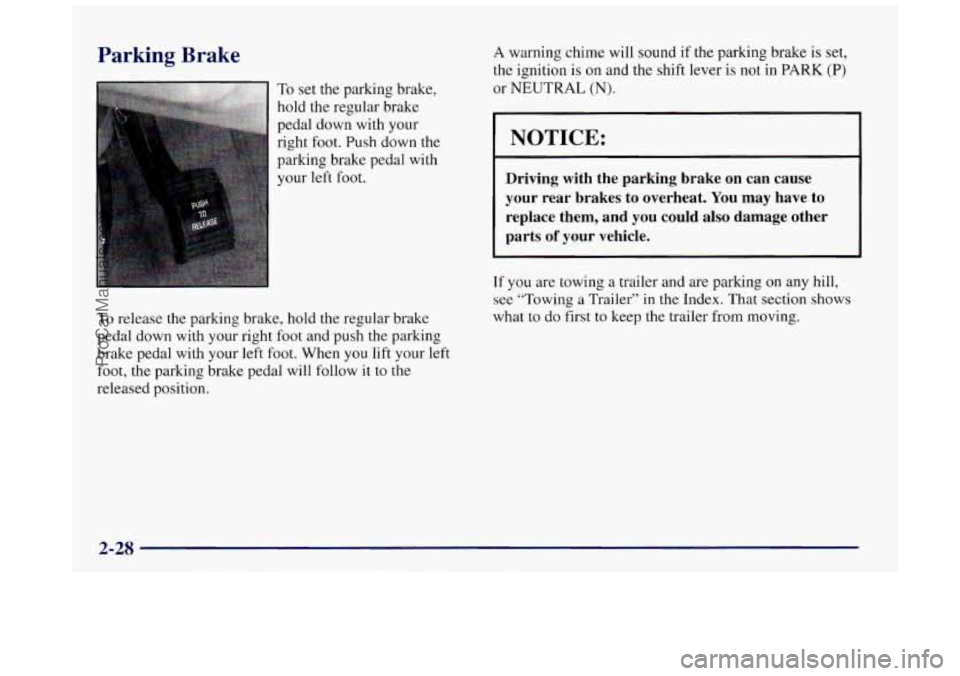
Parking Brake
To set the parking brake,
hold the regular brake
pedal down with your
right foot. Push down
the
parking brake pedal with
your
left foot,
To release the parking brake, hold the regular brake
pedal down with your right foot and push the parking
brake pedal with your left foot. When
you lift your left
foot, the parking brake pedal will follow it
to the
released position.
A warning chime will sound if the parking brake is set,
the ignition
is on and the shift lever is not in PARK (P)
or NEUTRAL (N).
I NOTICE:
Driving with the parking brake on can cause
your rear brakes to overheat. You may have to
replace them, and
you could also damage other
parts
of your vehicle.
If you are towing a trailer and are parking on any hill,
see “Towing
a Trailer” in the Index. That section shows
what
to do first to keep the trailer from moving.
2-28
ProCarManuals.com
Page 105 of 422
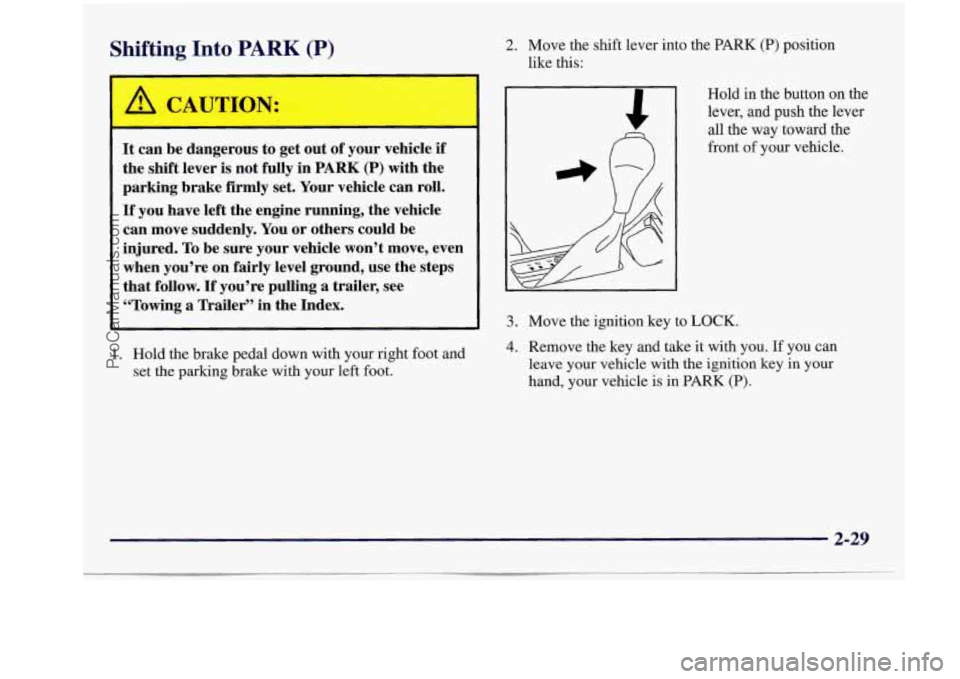
Shifting Into PARK (P) 2. Move the shift lever into the PARK (P) position
like this:
It can be dangerous to get out of your vehicle if
the shift lever
is not fully in PARK (P) with the
parking brake firmly set. Your vehicle can roll.
If you have left the engine running, the vehicle
can move suddenly. You or others could be
injured.
To be sure your vehicle won’t move, even
when you’re on fairly level ground, use the steps
that follow.
If you’re pulling a trailer, see
“Towing
a Trailer” in the Index.
1. Hold the brake pedal down with your right foot and
set the parking brake with your left foot. Hold in the button on the
lever, and
push the lever
all the way toward the
front
of your vehicle.
3. Move the ignition key to LOCK.
4. Remove the key and take it with you. If you can
leave your vehicle
with the ignition key in your
hand, your vehicle is in
PARK (P).
2-29
ProCarManuals.com
Page 106 of 422
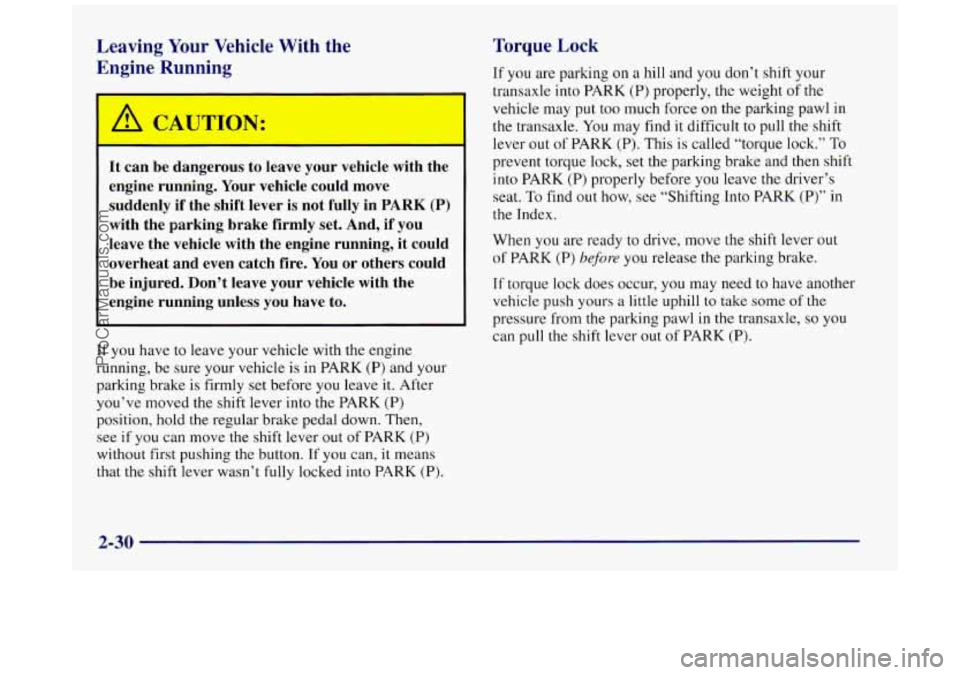
Leaving Your Vehicle With the
Engine Running
It can be dangerous to leave your vehicle with the
engine running. Your vehicle could move
suddenly if the shift lever
is not fully in PARK (P)
with the parking brake firmly set. And, if you
leave the vehicle with the engine running,
it could
overheat and even catch fire. You or others could
be injured. Don’t leave your vehicle with the
engine running unless you have to.
If you have to leave your vehicle with the engine
running, be sure your vehicle is in PARK (P) and your
parking brake is firmly
set before you leave it. After
you’ve moved the shift lever into the PARK (P)
position, hold the regular brake pedal down. Then,
see
if you can move the shift lever out of PARK (P)
without first pushing the button. If
you can, it means
that the shift lever wasn’t fully locked into PARK
(P).
Torque Lock
If you are parking on a hill and you don’t shift your
transaxle into PARK (P) properly, the weight of the
vehicle may put too much force on the parking pawl in
the transaxle.
You may find it difficult to pull the shift
lever out
of PARK (P). This is called “torque lock.” To
prevent torque lock, set the parking brake and then shift
into PARK
(P) properly before you leave the driver’s
seat.
To find out how, see “Shifting Into PARK (P)” in
the Index.
When you are ready to drive, move the shift lever out
of PARK (P) before you release the parking brake.
If torque lock does occur, you may need to have another
vehicle push yours
a little uphill to take some of the
pressure from the parking pawl in the transaxle, so you
can pull the shift lever out of PARK (P).
2-30
ProCarManuals.com
Page 107 of 422
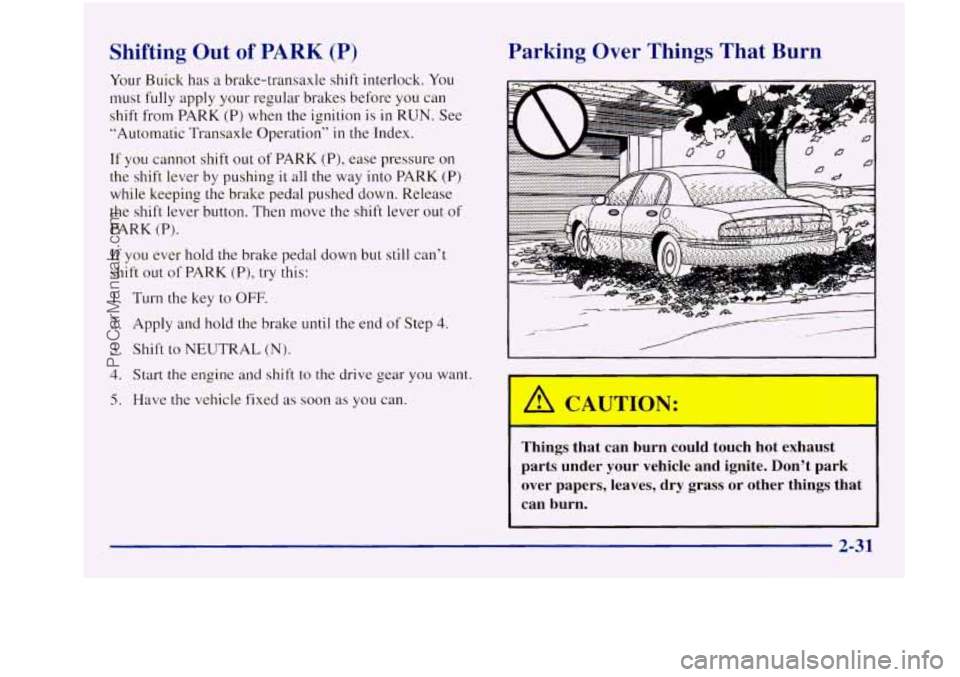
Shifting Out of PARK (P)
Your Buick has a brake-transaxle shift interlock. You
must fully apply your regular brakes before you can
shift from PARK (P) when the ignition
is in RUN. See
“Automatic Transaxle Operation” in the Index.
If
you cannot shift out of PARK (P), ease pressure on
the shift lever by pushing
it all the way into PARK (P)
while keeping the brake pedal pushed down. Release
the shift lever button. Then move the shift lever out of
PARK
(P).
If you ever hold the brake pedal down but still can’t
shift out of PARK
(P), try this:
1. Turn the key to OFF.
2. Apply and hold the brake until the end of Step 4.
3. Shift to NEUTRAL (N).
4. Start the engine and shift to the drive gear you want.
5. Have the vehicle fixed as soon as you can.
Parking Over Things That Burn
I
Things that can burn could touch hot exhaust
parts under your vehicle and ignite. Don’t park
over papers, leaves, dry grass or other things that
can burn.
2-31
ProCarManuals.com
Page 109 of 422
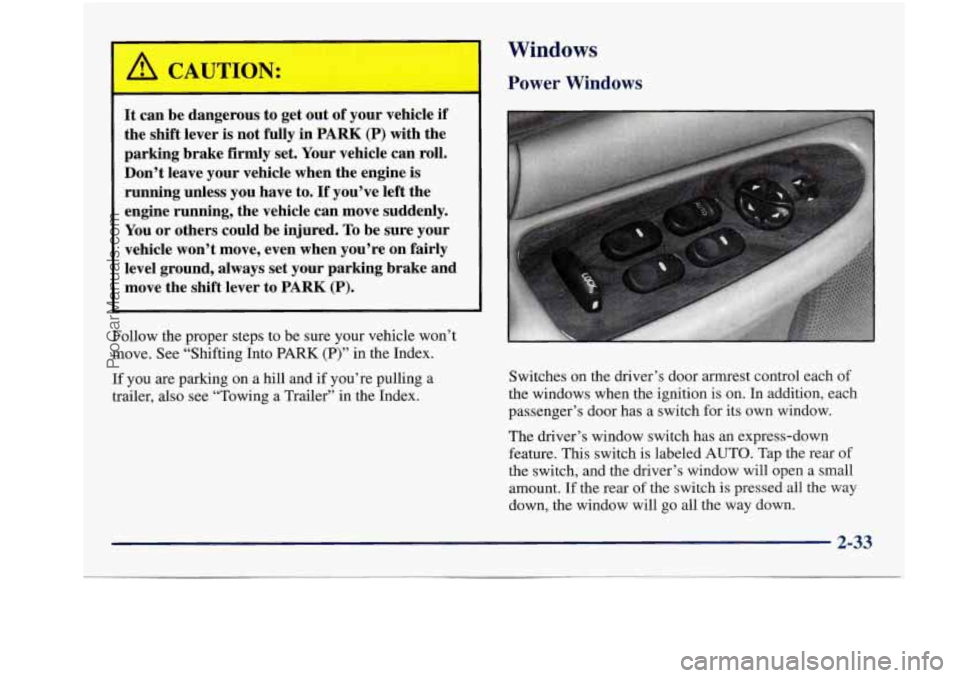
I
I
It can be dangerous to get out of your vehicle if
the shift lever is not fully in PARK (P) with the
parking brake
firmly set. Your vehicle can roll.
Don’t leave your vehicle when the engine
is
running unless you have to. If you’ve left the
engine running, the vehicle can move suddenly.
You or others could be injured.
To be sure your
vehicle won’t move, even when you’re on fairly
level ground, always set your parking brake and
move the shift lever to
PARK (P).
Follow the proper steps to be sure your vehicle won’t
move. See “Shifting Into
PARK (P)” in the Index.
If you are parking on a hill and if you’re pulling a
trailer, also see “Towing a Trailer” in the Index.
Windows
Power Windows
Switches on the driver’s door armrest control each of
the windows when the ignition is on. In addition, each
passenger’s door has a switch for its own window.
The driver’s window switch has an express-down
feature. This switch is labeled
AUTO. Tap the rear of
the switch, and the driver’s window will open a small
amount. If the rear of the switch
is pressed all the way
down, the window will go all the way down.
2-33
ProCarManuals.com
Page 118 of 422
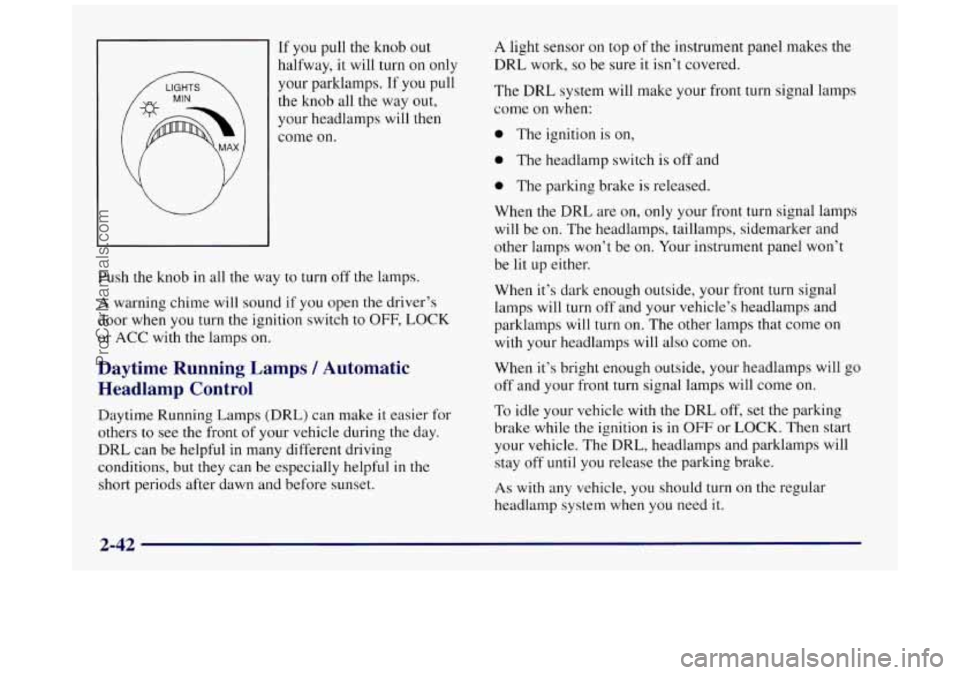
If you pull the knob out
halfway,
it will turn on only
your parklamps. If you pull
the knob all the way out,
your headlamps
will then
come on.
Push the knob
in all the way to turn off the lamps.
A warning chime will sound if you open the driver’s
door when you turn the ignition switch to
OFF, LOCK
or
ACC with the lamps on.
Daytime Running Lamps / Automatic
Headlamp Control
Daytime Running Lamps (DRL) can make it easier for
others to see the front
of your vehicle during the day.
DRL can be helpful in many different driving
conditions, but they can be especially helpful
in the
short periods after dawn and before sunset.
A light sensor on top of the instrument panel makes the
DRL work,
so be sure it isn’t covered.
The DRL system will make your front turn signal lamps
come on when:
0 The ignition is on,
0 The headlamp switch is off and
0 The parking brake is released.
When the DRL are on, only your front turn signal lamps
will be on. The headlamps, taillamps, sidemarker and
other lamps won’t be on. Your instrument panel won’t
be lit up either.
When it’s dark enough outside, your front turn signal
lamps will turn off and your vehicle’s headlamps and
parklamps will turn
on. The other lamps that come on
with your headlamps will also come on.
When it’s bright enough outside, your headlamps will
go
off and your front turn signal lamps will come on.
To idle your vehicle with the DRL off, set the parking
brake while
the ignition is in OFF or LOCK. Then start
your vehicle. The DRL, headlamps and parklamps will
stay off until you release the parking brake.
As with any vehicle, you should turn on the regular
headlamp system when you need
it.
2-42
ProCarManuals.com